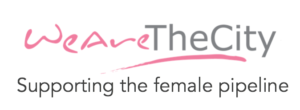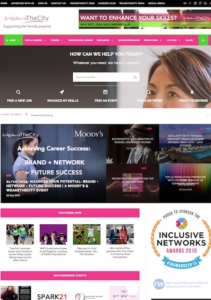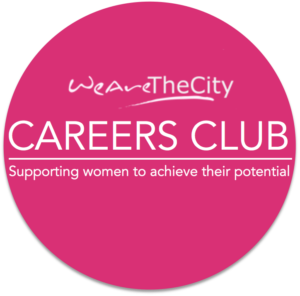“The Toigo Foundation is committed to ethical leadership and broader diversity of thought and experience in business. Our mission is to foster the career advancement and increased leadership of underrepresented talent by creating mechanisms for greater inclusion from the classroom to the boardroom.”
WeAreTheCity.com was founded in April 2008 with the aim of providing information to women who wish to progress in their careers via networking and events. The concept of the website is to provide services that not only help women develop themselves both personally and professionally, but also contributes to a wider strategy of supporting working women in the UK more broadly by bringing together the charity sector and potential entrepreneurs on to one common platform.
WeAreTheCity’s core pillars are as follows:
- To provide an inspirational platform for women who wish to learn, progress and drive their own professional growth.
- To raise awareness of female related networks, events & training to promote the importance of networking and gaining new skills.
- To connect and encourage women to give back and share their time/skills with charities, social enterprises, schools and the pipeline of future corporate women.
- To provide a suite of programmes and services to assist organisations who are actively seeking to enhance the careers and prospects of their female talent pipeline.
WeAreTheCity in numbers (Sep 2015)
- 6 million hits per month
- 200,000 unique visitors
- 40,000 members (80% professional women)
- <5,000 Alexa ranked UK website
- Access to 18,000 women through our social media channels (Twitter, Facebook, Linkedin)
- 4,500+ articles (all articles receive in excess of 1k views)
- 60+ events delivered/co-partnered
- £70,000 raised for charity
Core service and programme offerings aimed at corporate clients
WeAreTheCity provide the following services & programmes to a number of organisations who are seeking to support and enhance the careers of their female workforce
- Careers Club – Online careers support club aimed at enhancing the skills of junior to middle management
- Recruitment and job board via WeAreTheCity Jobs
- Mentoring – Industry specific
- Global Webinars
- Talent attraction events
- Maternity Coaching
- Training – Client handling, CRM, Personal Development
For more information about our corporate services, please contact Info@wearethecity.com
In 2012 WeAreTheCity was recognised by both Mumprenuer and the Good Web Guide for our work in the female community.
In 2015, WeAreTheCity was awarded the Company of the Year Award by RBS Focused Women
WeAreTheCity also has a sister site in India, www.wearethecity.in.
 By Michelle Hendelman, Editor-in-Chief
By Michelle Hendelman, Editor-in-Chief
Innovation is a word that is often used in association with business growth and competitiveness, but what does innovation in action look like and how can you make sure you are flexing your innovative muscles at work?
Recently, Harvard Business Review reported that the lack of innovation was one of the biggest mistakes Steve Ballmer made as CEO of Microsoft. He didn’t necessarily do anything wrong. After all, he did manage to keep Microsoft’s stock price steady during his time as the company’s leader. But, he didn’t really create a “wow factor” around Microsoft or its product lines either. As a result, Ballmer has been the topic of much media debate over whether or not he led the company with enough attention on innovation.
While Microsoft has not met the same demise as former tech giant, RIM, the message to companies is pretty clear: innovate or die. Julia Kirby, author of the HBR article writes, “Despite two decades of seeing the problem, very few CEOs have thought seriously about how their organizations should be reinvented if innovation matters more than anything else. Well, guess what: it does.”
As a recent Deloitte report suggested that innovation is not limited to a select few within a company’s org chart. Instead, companies need to start recognizing the value of institutional innovation, which Deloitte describes as, “redefining the rationale for institutions and developing new relationship architectures within and across institutions to break existing performance trade-offs and expand the realm of what is possible.”
Where do you fall on the innovation spectrum?
If innovation is becoming the cornerstone of competitive businesses, innovative people will become even more valuable. If you want to remain an asset to your company, you need to continue to sharpen your innovation skills, so that when the opportunity arises to turn ideas into actions, you will be ready. The following tips will help you keep innovation on the top of your to-do list each and every day.
 By Melissa J. Anderson (New York City)
By Melissa J. Anderson (New York City)
A few months ago, a friend of mine wrote a post on Facebook about something that had frustrated her at work. My friend, who works in a technology role for a federal contractor, had received an email from a male colleague, asking if she wouldn’t mind helping to set up the office kitchen for a team party. All of the other women on the team got the email. None of the men did.
This may seem like a small thing, being asked to set up some refreshments for an office party. But, when you add up the consequences of being asked throughout your entire professional career to do these small chores, it’s not. Microinequities like these are the building blocks that make up a workplace culture that positions women as the helpers, the cleaners, the fixers, the note-takers, the coffee-makers, the party planners, the support staff to the “real” workers – even if their job description is the same as everyone else’s.
The second shift sees women in dual career households coming home at the end of the day, and doing the majority of housework and childcare compared to their partner. Even women in full time jobs who make more money than their husbands do the same amount or more at home, a recent Simmons College study [PDF] showed.
But the second shift is not simply a phenomenon that takes place after work. It’s a symptom of a broader cultural expectation that women clean up messes wherever they are. Women are getting stuck with the second shift at work too. And doing all that extra work, work that’s not considered mission critical in the least bit, can be a drag on your time and your power.
My friend did something brave. Rather than sigh heavily and just go help set up, she chose not to ignore the sexist slight. She replied to the email, pointing out that none of the men on the floor were asked to help out with the party, and it’s not appropriate to expect only women to.
That’s another factor – it takes a lot of courage to stand up to microinequities. Since they’re so small, the perpetrator may not even realize he or she did anything wrong. It’s easy for them to laugh it off as a joke, or worse, accuse the aggrieved of overreacting. And in the immediate sense, the payoff is small.
But calling out this kind of behavior is a long game, and ultimately it makes the work environment a more equitable place where women will be taken seriously. In the short term, at least you won’t be fuming later over what you “should have said.”
Read more
 In college, Karen Catlin chose to major in computer science at Brown University, despite the fact that she was not extremely familiar with computers. But as it turned out, Catlin discovered early on that she enjoyed the challenge presented to her through her computer science studies. “I enjoyed solving problems and I loved math, so it was a nice combination that allowed me to explore problem solving techniques based on mathematics,” said Catlin.
In college, Karen Catlin chose to major in computer science at Brown University, despite the fact that she was not extremely familiar with computers. But as it turned out, Catlin discovered early on that she enjoyed the challenge presented to her through her computer science studies. “I enjoyed solving problems and I loved math, so it was a nice combination that allowed me to explore problem solving techniques based on mathematics,” said Catlin.
After a successful career working as a senior executive in the technology industry, Catlin is now focused on making sure women working in tech today have the resources to be successful. “I want to make sure women in tech are not opting out of the industry for the wrong reasons,” explained Catlin. “I want women to feel empowered, educated, and encouraged to have the career that they aspire to.”
Highlights in Catlin’s Career
After graduating, Catlin accepted a job at Brown researching hypertext, which was an innovative function at the time. “This was a great opportunity for me get involved with this research that was growing at the time,” explained Catlin.
Catlin moved to London with her husband, who is originally from England. Here she had the opportunity to work at a Hitachi Research Lab that was based in the UK. “It was a great experience not only working in the UK, but also working for a Japanese firm,” Catlin said. “I highly recommend that everyone gains some international experience if they can. It teaches you the skills that you need in order to be effective in different environments and different cultures.”
Although her experience working abroad allowed Catlin to gain valuable knowledge and add essential skills to her toolkit, she and her husband, who is a software developer, both felt like if they were going to work seriously in the technology industry, there was only one place for them to be. So, they packed their bags and headed back to the US with their sights set on Silicon Valley.
Catlin immediately found a job working for Go Corporation, a company that was working on tablet technology long before anyone else. She recalled being intimidated at the time even though she had a great technical background and education in technology. “If I knew the term ‘Impostor Syndrome’ at the time, I would have definitely said that I had it,” said Catlin. “I wasn’t sure I was up to getting an engineering job, so instead I got a job writing software and documentation that would teach other engineers how to write code.”
While she loved teaching other engineers, Catlin also discovered that she also enjoyed the challenge of getting things organized. She explained, “At the time Go was experiencing a lot of changes to their software specs, and they needed someone to guide the development team through this process. So I become involved in technical project management. I transitioned from being a software engineer to a manager at that point.”
Read more
The idea that “masculine identity” is a social construct is not a new one. As Robin Ely, Professor of Business Administration and Senior Associate Dean for Culture and Community, points out, different cultures associate different attributes with men and masculinity, but in almost all cultures, such attributes—whatever they may be—are more highly valued than those associated with women and femininity.
Ely’s recent study, a collaboration with her colleague, Stanford University consulting professor Debra Meyerson, proves without a shadow of a doubt that an entire culture can dramatically shift when stripped of its traditional masculine identity.
“Unmasking Manly Men: The Organizational Reconstruction of Men’s Identity” took Ely and Meyerson 130 miles off the coast of Southern Louisiana, landing them smack-dab in the middle of one of the toughest, most male-dominated work environments imaginable: an offshore oil platform. The manager of the oil rig had implemented innovative approaches to leadership development in order to reduce unsafe behaviors stereotypically associated with “macho” men, such as taking unnecessary risks, refusing to ask questions that make them appear vulnerable, and pressuring coworkers to prove themselves through acts of physical bravery. However, he wasn’t achieving an effective result.
He found that by stripping the oil rig away of its traditional masculine identity, there was a noticeable shift in the entire culture of the rig: communication improved, men listened to each other more, they learned from their mistakes, and placed more emphasis on teamwork.
So, what does work on an oil rig have to do with corporate America? The concept of not just pushing against masculine leadership stereotypes, but dismantling them entirely can be transferred to the corporate landscape. This could be necessary if organizations continue conflating concepts of leadership competence with images of masculinity.
Ely says the research speaks to the question of how men construct identities in the workplace and the larger role organizations play in shaping this process. “In other research,” she says, “we have seen that conventional masculinity often becomes the performance standard, even when an alternative standard would be more beneficial to the organization, not to mention to women employees with an interest in career advancement.”
Read more
 By Melissa J. Anderson (New York City)
By Melissa J. Anderson (New York City)
Critical mass, the generally accepted theory regarding women on boards and executive management, says that when women occupy more than 30 percent of the positions in a specific group, positive social change within the organization starts to happen.
That is, when you have a certain number of women in elite circles of leadership, the theory suggests that firms will have better representation of women at senior levels. The firm will put more effort into recruiting and retaining women, leadership styles will improve as more diverse models emerge, discussions will become more inclusive and dynamic, attitudes about who’s suited for which jobs will change, and the company will perhaps devote more resources to the types of programs that level the playing field for women.
But there’s an uncomfortable gray area between having no women in a group of leaders and having three or more women in that group, and that area is tokenism.
Tokenism isn’t just bad because it implies that token women don’t really “deserve” their spot. In fact, token women are by and large accomplished and deserving of their role, and they probably fought tooth and nail against negative stereotypes to get it, only to have people (both men and women) in their firm consider them undeserving of their title.
In fact, tokenism also harms all women. When leadership groups are still at the tokenism stage of diversity, token individuals are set up to compete mainly with one another, and they are likely see other token individuals as a threat to their own power.
A new working paper out of Columbia Business School and the University of Maryland Robert H. Smith School of Business indicates that tokenism is alive and well at today’s top companies. The research shows that tokenism is actually keeping women out of top jobs. The longitudinal study of companies in the S&P 1,500 shows that when organizations find themselves with a female CEO, they are less likely to have women in other top jobs, especially line positions. Similarly, when a woman is in one category (line versus staff) of senior management positions, it is less likely that there are other women in senior management positions in that category.
As the percentage of women in senior management roles at top companies is increasing at a glacial pace (for example, in 2012, only 14.3 percent of Fortune 500 companies had a female CEO, a marginal increase since 2009 when it was 13.5 percent), now may be a critical time to examine why. Is tokenism keeping more women out of top jobs? What role are other women playing here? It’s not a pretty picture.
Read more
 By Michelle Hendelman, Editor-in-Chief
By Michelle Hendelman, Editor-in-Chief
Deborah Lorenzen, COO, BK University, BNY Mellon, recently celebrated her 20th anniversary with BNY Mellon. This milestone is enriched by a career that has been fundamentally involved in the growth, development and enrichment of the company’s structure, business strategies and corporate culture.
Lorenzen has taken on roles in many different disciplines, locations and business units at BNY Mellon including special projects, program management, and Corporate Trust. She’s worked in San Francisco, New York, Edinburgh and London. Now in her latest role as COO of BK University, Lorenzen hopes to be part of an exciting new era of transformative change at the global financial services company. BNY Mellon provides services and solutions across the investment lifecycle.
The roots for BK University and Lorenzen’s involvement in the project were actually planted in the late nineties when she received an unexpected phone call at her desk. “One day my phone rang and it was Gerald Hassell, who had just become president of the company. He was calling because he wanted someone who could figure out how to launch a corporate University. And it took some time to get here, but I am now the COO of BK University. At the time, we weren’t ready for this on an institutional level, but now we are,” recalls Lorenzen.
On Defining a Career Path
When she looks back at her career path, Lorenzen agrees that it was not the most linear. However, she feels that her deep vault of experiences is what has shaped her and prepared her for her current role. Lorenzen said, “My interests are in how we run this company and becoming part of the leadership team that helps drive this company forward. Perhaps there could have been a more direct career path, but for me it was really important to understand a number of different disciplines and to be a more effective and well-rounded leader with the perspective to go along with the global nature of our business.” She continued, “Every single opportunity I took has helped me to understand our business more deeply.”
For Lorenzen, taking advantage of the opportunities presented to her throughout her career has contributed to her success at BNY Mellon. “I believe the greatest risk you can take in your career is to stand still,” said Lorenzen, “You have to move and you have to put yourself out of your comfort zone because that is the only way you learn. You don’t regret the things that you do. You may regret the things you don’t do.”
Impacting the culture of her company in a positive way is something that has always been a source of pride for Lorenzen. “One of the things I am most proud of is the time that I have spent connecting people,” explained Lorenzen. “I once spent six months in Edinburgh working with 400 employees of a business we had just acquired. I helped them understand how we got things done in this organization and explained the culture of our company. I enjoy making those linkages for people so that they can be more successful.”
Read more
 By Michelle Hendelman, Editor-in-Chief
By Michelle Hendelman, Editor-in-Chief
“Despite all of the myths of women’s competitiveness, we know how to stick together,” said Robin Morgan. To Morgan, this is one of the things that make women so special. “Solidarity is not just an abstraction to women,” she continued, “it’s a practical reality, day in and day out.” It is this unique element, according to Morgan, that keeps the women’s movement going strong in the 21st century.
Morgan stated, “I am extremely proud of the fact that I have had the opportunity to be a political activist in what is the most important social and political movement on the planet, at this point in history.”
Forging Her Own Path in Activism
Morgan explained, “I had been active in the antiwar movement and in the Civil Rights movement during the sixties and seventies, and like many young women I assumed we were all fighting for equality for everyone. I thought we were going to march with our brothers, arm-in-arm, toward this great revolutionary transformation– only to find that it didn’t include women.”
She continued, “Women were expected to make coffee, not policy. It was a complete mirror image of the patriarchy we were supposed to be fighting.” This realization was a radicalizing experience for Morgan, and influenced her involvement in founding the first feminist caucus in the Civil Rights organization SNCC (Student Nonviolent Coordinating Committee), together with now-Rep. Eleanor Holmes Norton. Morgan and women in other feminist caucuses of New Left groups faced staunch opposition from men, who pelted them with tomatoes, eggs, and even rocks when they tried to speak in meetings. This backlash was a major catalyst for Morgan’s decision to distance herself from what she came to refer to as the “male left.”
Another key moment for Morgan occurred in 1968, when the Democratic National Convention was being held in Chicago, and was expected to draw (and did) a significant amount of protest activity from radical groups. Instead of joining these protests, Morgan had already decided to organize what would become a historical protest at the annual Miss America Pageant. Here, during this nationally televised event, Morgan and other members of New York Radical Women brought attention to the Women’s Movement by outwardly protesting against symbols of female oppression.
In her final public display of separation from the male left, Morgan published a piece in an underground newspaper, entitled, “Goodbye to All That,” in which she named popular male leaders of the left and called them out for their degradation of women being no different than men of the odious right. “Being a writer, first and foremost, the pen was my most powerful tool. Depending on how you look at it, this piece became very famous–or infamous,” said Morgan.
“That shut the door,” she recalled. From here, Morgan went on to publish Sisterhood Is Powerful, one of the most popular and critically acclaimed books of the 20th century. Many people credit this collection of women’s essays with starting contemporary American feminism.
Read more
 By Melissa J. Anderson (New York City)
By Melissa J. Anderson (New York City)
By now everyone has heard about sponsorship and how it can expand women’s career opportunities, right?
Not quite.
Despite sponsorship being a “buzz-word” in the women’s career advancement space for the past few years, the topic remains somewhat mysterious for a lot of people. At least, that’s what our latest study, “Women in Technology: Leaders of Tomorrow,” [PDF] suggests.
We polled almost 200 junior and mid-level women in technology jobs for the report, which was sponsored by Accenture. Our respondents provided us with a lot to work with – most notably, almost two-thirds said they hope to have a senior management or C-suite job someday. By most measures, these women aren’t suffering from the so-called lack of ambition that many have blamed for leadership diversity’s stalling progress. In fact, you could say these women seem to be “leaning in” pretty hard already.
Even still, most of the women who took our survey didn’t feel their companies were really “leaning in” to them in equal measure. In fact, only a quarter (24.5 percent) said that their company was “walking the talk,” by providing support that matched up with the verbal promises made by management to support women.
One of the results of haphazard or half-effort approaches to providing career development opportunities and training for women is that people don’t hear correct or full answers about what can actually help propel them to the top.
One of these things is sponsorship. Our research revealed a lot of confusion amongst our respondents about what sponsorship really entails. Sponsorship is so important for career advancement for everyone, but especially women – studies by Catalyst and the Center for Talent Innovation have confirmed this.
Women need to get a clear picture of what it looks like since they’re the ones who stand to lose the most if their understanding of sponsorship remains blurred. It’s up to companies and corporate development programs to demystify sponsorship for their female workforces. Here’s what we found.
Read more
The Glass Hammer
Executive coaching, leadership development coaching and career navigation coaching for women looking to develop, advance and lead in top roles.




